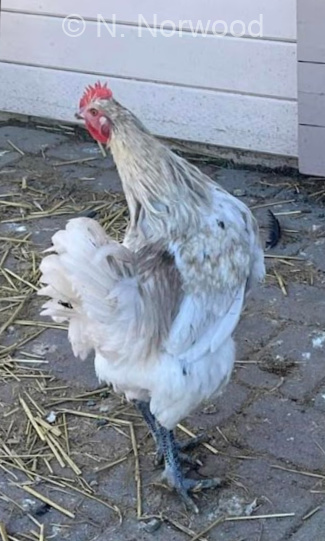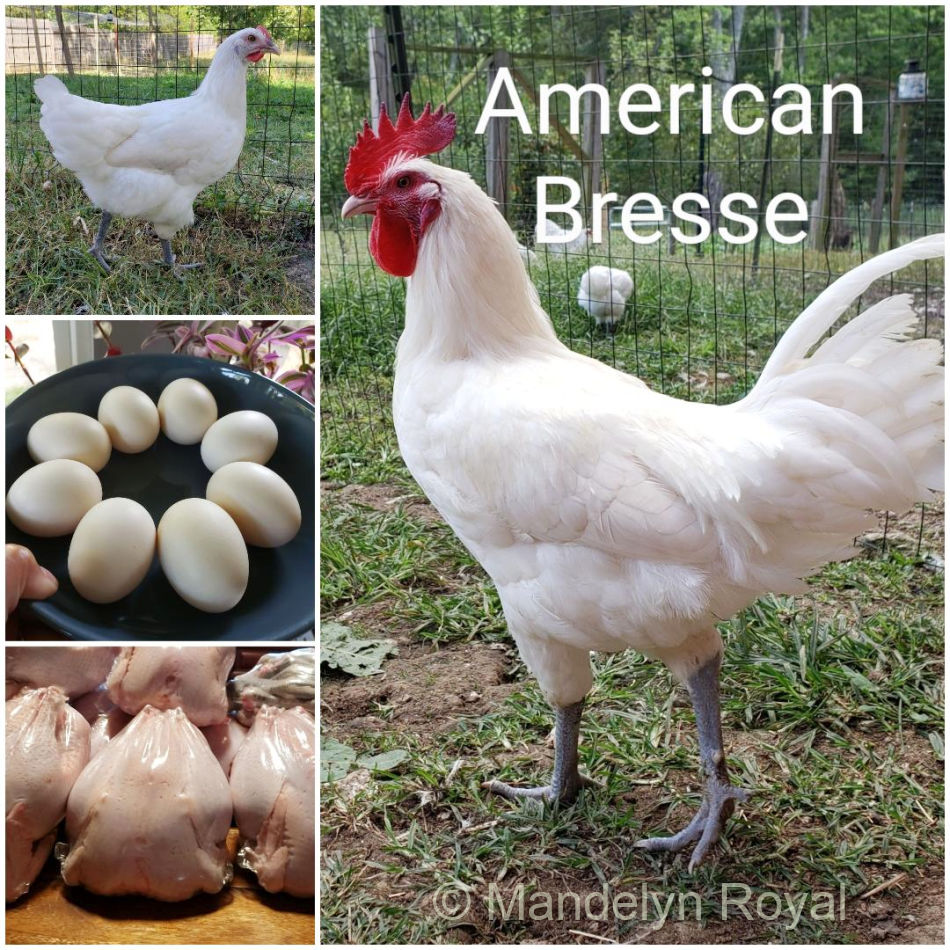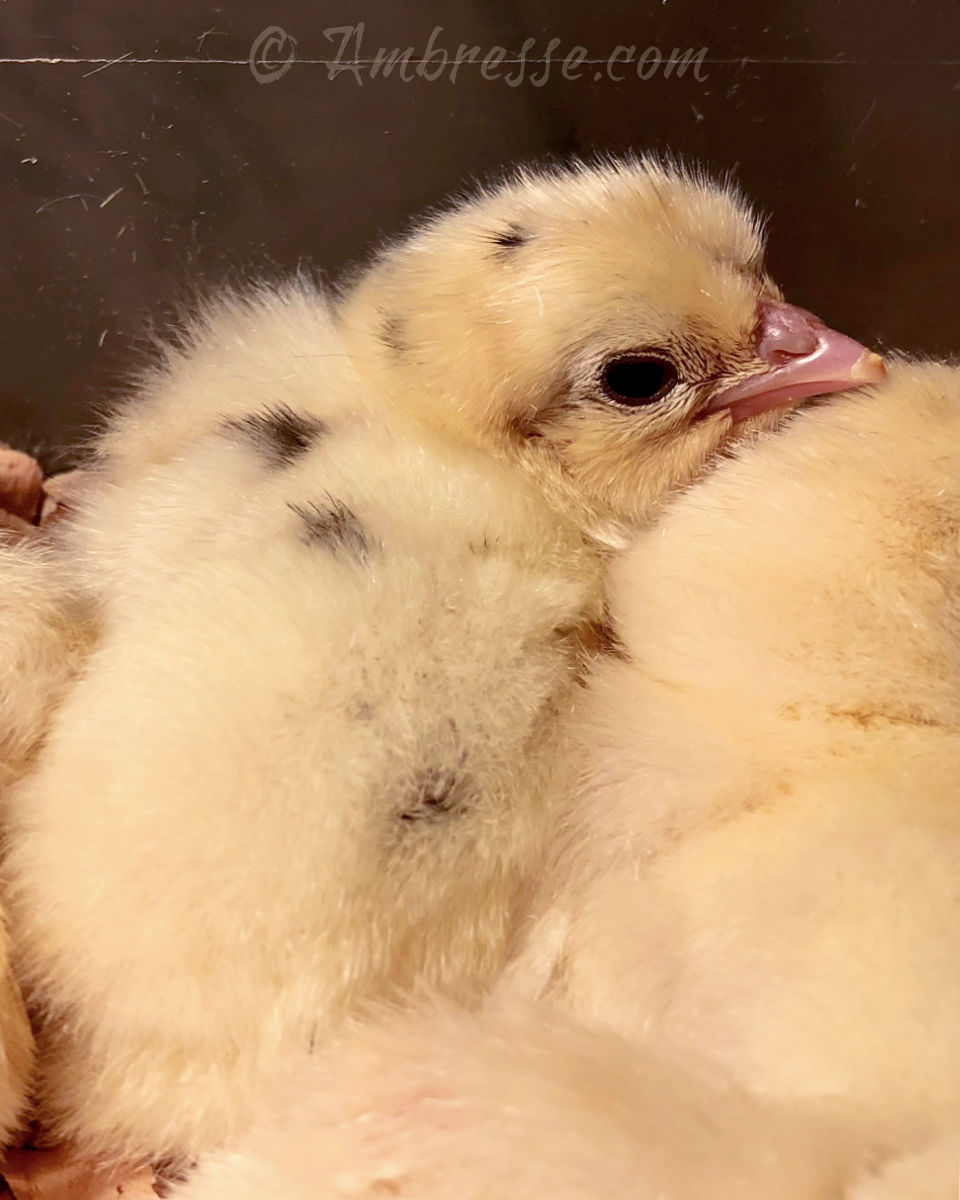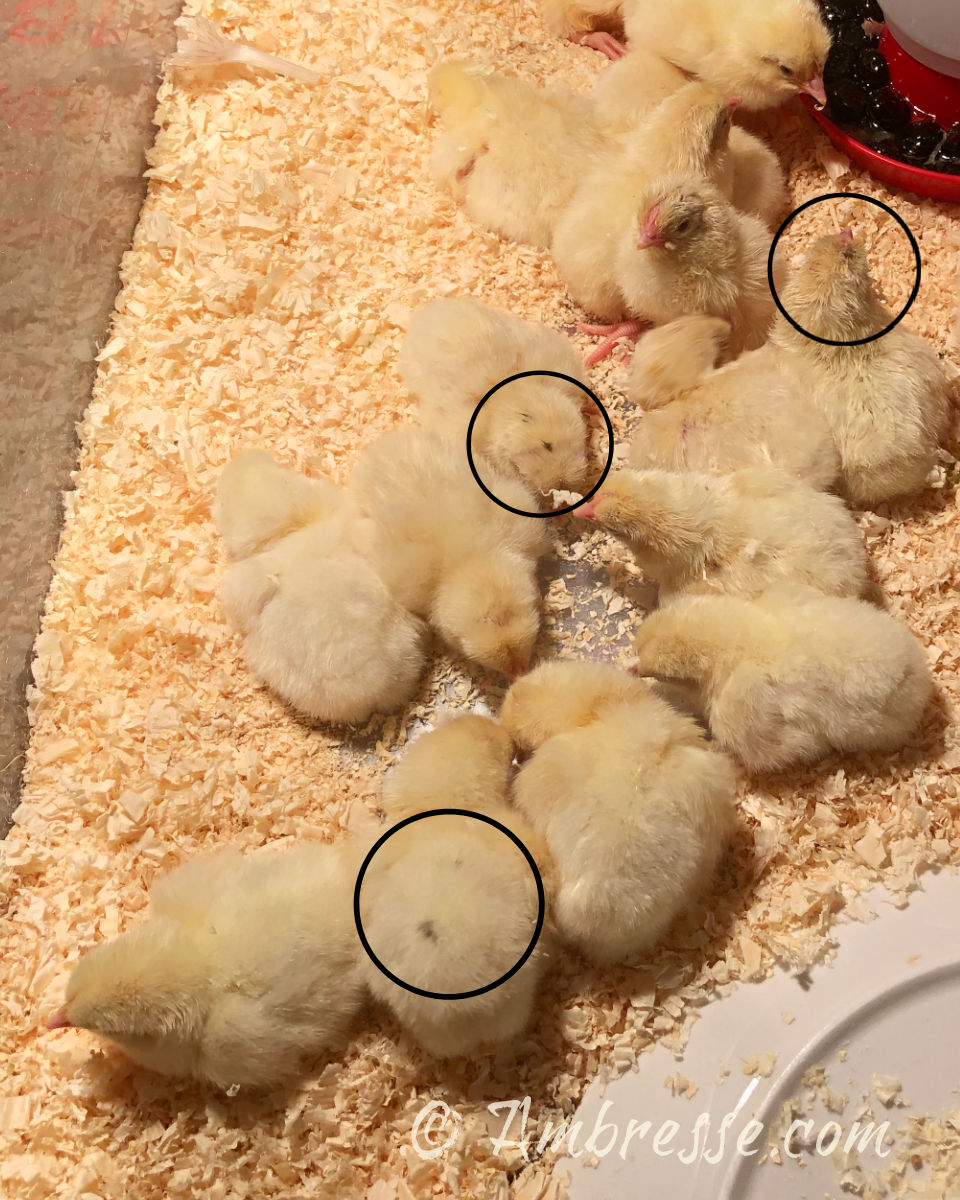Black Leakage in American Bresse Chickens
Black Leakage in American Bresse Chickens: Learn the genetics that allow bleed-through of black pigment into white feathers, and how to eliminate black leakage.
I'm not a chicken geneticist, but I know a breeder who is. Mr. Kerby Jackson has studied chicken genetics for many years, and he was graciously willing to explain the genetics of black leakage for the visitors of the Ambresse website.
Pictured: Obvious black leakage in a day-old White American Bresse chick. Click on the photo to view it in full size.
Keep reading for the full scoop on black leakage....
Black Leakage in American Bresse Chickens
By Kerby Jackson
The Reason for Black Spots on Otherwise White American Bresse Chickens
The reason that breeders occasionally produce birds with black tail feathers (or mixed black or mixed blue feathers) is that they have birds in their flock that are heterozygous for Dominant White instead of being homozygous for Dominant White.
Quite often, these birds will LOOK pure white, but if you examine the plumulaceous portion of the feather just above the skin (i.e. the so-called "fluff"), you'll often find that some of your whites are not really so white after all. In some cases, only a few feathers will appear affected and when it's the so-called "fluff," these can be very hard to detect without handling the bird VERY thoroughly. It is typically more apparent in the males and especially in the areas of male feathering.
Any of these heterozygous Dominant Whites (regardless of sex) are fully capable of making more heterozygous Dominant Whites even if you breed them to a homozygous bird. Keep in mind that Dominant White is epistatic, so it's always covering up something else. In Bresse, more often than not, this will be Black, but it could also be other things as well, which is why these "weird colors" pop out from time to time.
When you have heterozygous Dominant White covering Black, the most common expression is a White bird with a few wholly black feathers or partially black feathers.
Increasing the inbreeding co-efficiency helps to concentrate (identify) the recessive genes, but if the breeder wants to completely limit (eliminate) the expression of any colored plumage, one will need to conduct progeny testing, which will identify those birds that are homozygous for Dominant White.
Once you can find a pair of them, you will have eliminated all the heterozygous birds from future generations. (i.e. You will produce pure whites only, unless some sort of other mutation pops up that counteracts the epistatic effect of Dominant White).
If you do not already own a copy, I'd suggest looking for a late (1950's) edition of A.L. Hagedoorn's Animal Breeding, as he went into great detail about these types of progeny testing programs for the purpose of developing homogenic bloodlines.”
Black Leakage in American Bresse: Is it Sex-Linked?
Is black leakage in American Bresse sex-linked? It's not really a matter of sex-linkage in the traditional sense, but birds are heterogametic in that the hens basically have one diminutive chromosome. Genes that might "ride on that chromosome" often have stronger expressions in males as males possess two normal chromosomes in that position. (The polar opposite of we human males).
As a result, the males can often carry some additional genetic information that the hens do not. That sometimes alters the natural expression of plumage color (which is one explanation as to how in some bird species, the males possess flashy plumage while the females in the same species are usually drab colored, though it's not the only explanation for the color difference).
 The result of a white to a white breeding. This cockerel shows yellow hues around the neck hackles and wings due to yellow leakage, and spots of black leakage. Photo Credit: Nancy Norwood.
The result of a white to a white breeding. This cockerel shows yellow hues around the neck hackles and wings due to yellow leakage, and spots of black leakage. Photo Credit: Nancy Norwood.From a personal standpoint, I've actually bred plenty of American Bresse hens that show the occasional black or variegated feather, but in general, the males do seem to possess a stronger expression in their phenotype than the hens do. Some of this seems to lie in the fact that the male feathering seems to be far more prone to being adversely affected. We see that especially where leakage is concerned, but there seems to be a high percentage of those black feathers that turn up in the sickles, in the saddles and in the wing bows on the males.
Even as someone with a genetics background, I don't entirely have a complete answer on the "why?" of it beyond the fact that they are males.
By contrast, in my Campines, I only see irregularities in color on the males that possess or later develop male feathering with age, but NEVER on the males that possess the desired for hen feathering unless they suddenly develop "hangers" in their 2nd or 3rd year. So the male feathering itself seems to be a major factor.
I am not really too concerned about the black or variegated feathers that appear on the heterozygous birds since it really has no impact on the carcass quality (I've yet to see one of these heterozygous birds show ink spots or other pigment blemishes on their carcass), but at the same time, I don't quite automatically cull them just on account of the color.
I have one heterozygous cockerel I bred last year with quite a strong expression for black leakage I was quite insistent on culling him early on just on account of the color, but the more I look at him lately, the more I'm considering the idea of actually using him this year as he really has the best type of any male that I bred last year. And I may actually mate him to one of his sisters who also has quite a few black or variegated feathers, but again, is really the best typed hen I bred.

Click here for information on Yellow Leakage in White American Bresse chickens, presented by Mr. Kerby Jackson.
More on White Genes in American Bresse, by Ms. Nancy Norwood.
About Kerby Jackson
Besides his extensive education in the field of poultry genetics, Mr. Kerby Jackson has been working with chicken color genetics for over forty years. One of his pet projects has been re-developing varieties of Campines. Additionally, he has been working on genetic projects involving American Bresse in combination with Brabanconne Red Plye, and a triple-breed project utilizing Leghorns, Golden Campines, and Golden Penciled Hamburgs.
Kerby lives in Grants Pass, Oregon.
See Kerby Jackson's Bio Here.
Breeder Contact Info: Kerby Jackson in OR
- Home
- ABC Genetics Questions
- Black Leakage
Overheard...
Tasty Recipe! "I processed my first batch of Bresse... Today I roasted one according (somewhat) to the recipe posted on Ambresse. It was delicious! Tender, moist and succulent... So happy I chose this breed!" (B.E., MN, 12/11/2024).
Success: "I can't believe all the inquiries we get through your website. And it's been a great resource to send people to who are interested in the (AB) breed" (Utangard Farm, NH, 5/5/2025).
Informational: "Your site has the first accurate information about American Bresse chickens that I have seen in English. Thanks for your diligent work" (L. Wooton, NC, 12/17/2024).
Translate This Page
Traduire Cette Page
Traduzca Esta Pagina

News
American Bresse Breed Club web pages can be found under the Breed Club tab on the navigation bar. Any changes in Club status will be posted here!

Photo credit: Mandelyn Royal.



